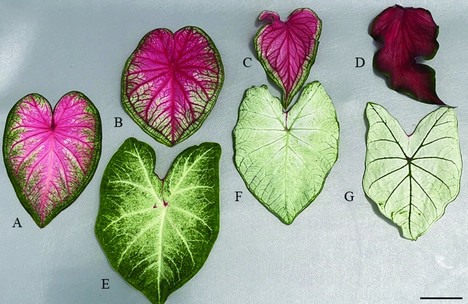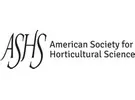Cultivated caladium (Caladium × hortulanum; 2n = 2x = 30) is an important ornamental aroid for the environmental horticulture industry. A better understanding of its genetic diversity is needed for the continued improvement of caladium. The caladium germplasm maintained in the University of Florida’s caladium breeding program were surveyed for potential variation in chromosome number and nuclear DNA content to gain a better understanding of caladium genetic diversity at the cytogenetic level.
For the first time, caladium triploidy was discovered in two breeding lines, UF-15-414 and UF-4407, with 2n = 3x = 45 chromosomes and a nuclear DNA content of 13.86 pg·2C−1. In addition, a new chromosome number (2n = 2x = 34) was found in one cultivar, ‘White Wing.’ Compared with their diploid parents or grandparents, the triploids showed a distinct, attractive leaf morphology with rounder and thicker leaves. The pollen stainability of UF-15-414 and UF-4407 was 63% and 73%, respectively, indicating potential male fertility, which was unexpected.

Analysis of simple sequence repeat (SSR) marker banding patterns confirmed that UF-15-414 was a direct progeny of UF-4407 through hybridization with the diploid cultivar Aaron, whereas UF-4407 might result from the fusion of an unreduced (female or male) gamete with a reduced gamete. Chromosome counting and SSR marker analysis of ‘White Wing’ and its progeny cultivars ‘White Wonder’ and ‘White Delight’ suggested that ‘White Wing’ possibly transmitted its 34 chromosomes to progeny during sexual reproduction.
The discovery and characterization of these triploids revealed the occurrence of natural sexual polyploidization in caladium and indicated good potential for creating and selecting new triploids for future caladium breeding. The observed new chromosome number in ‘White Wing’ and its progeny cultivars implies that other chromosome variations may be present among cultivated caladiums. In summary, these results revealed two male-fertile triploid caladiums and a new chromosome number that can enrich the cytogenetic diversity in future caladium cultivar development.
Read the complete research at www.journals.ashs.org.
For more information: American Society for Horticultural Science (ASHS)
American Society for Horticultural Science (ASHS)
ashs.org
